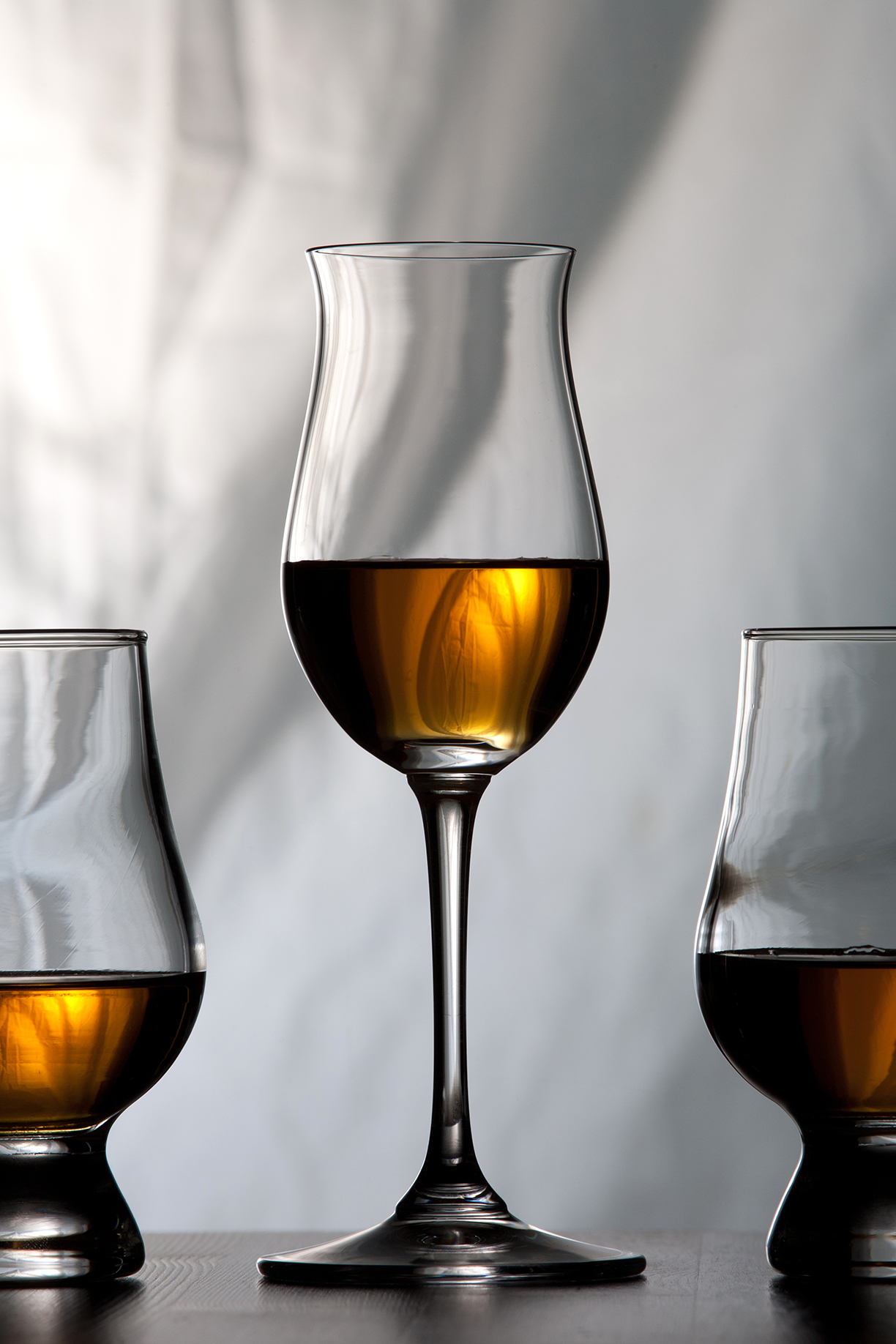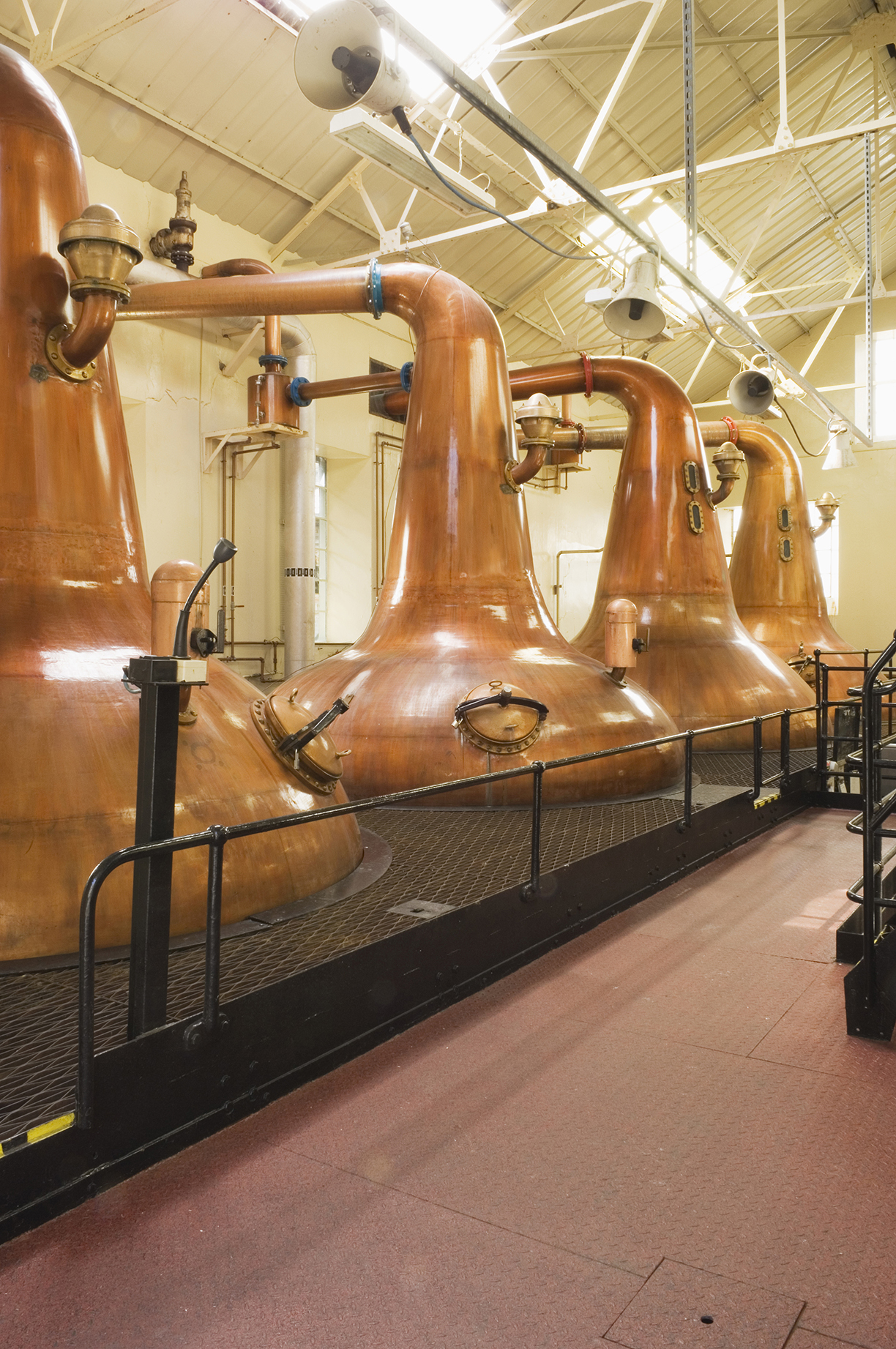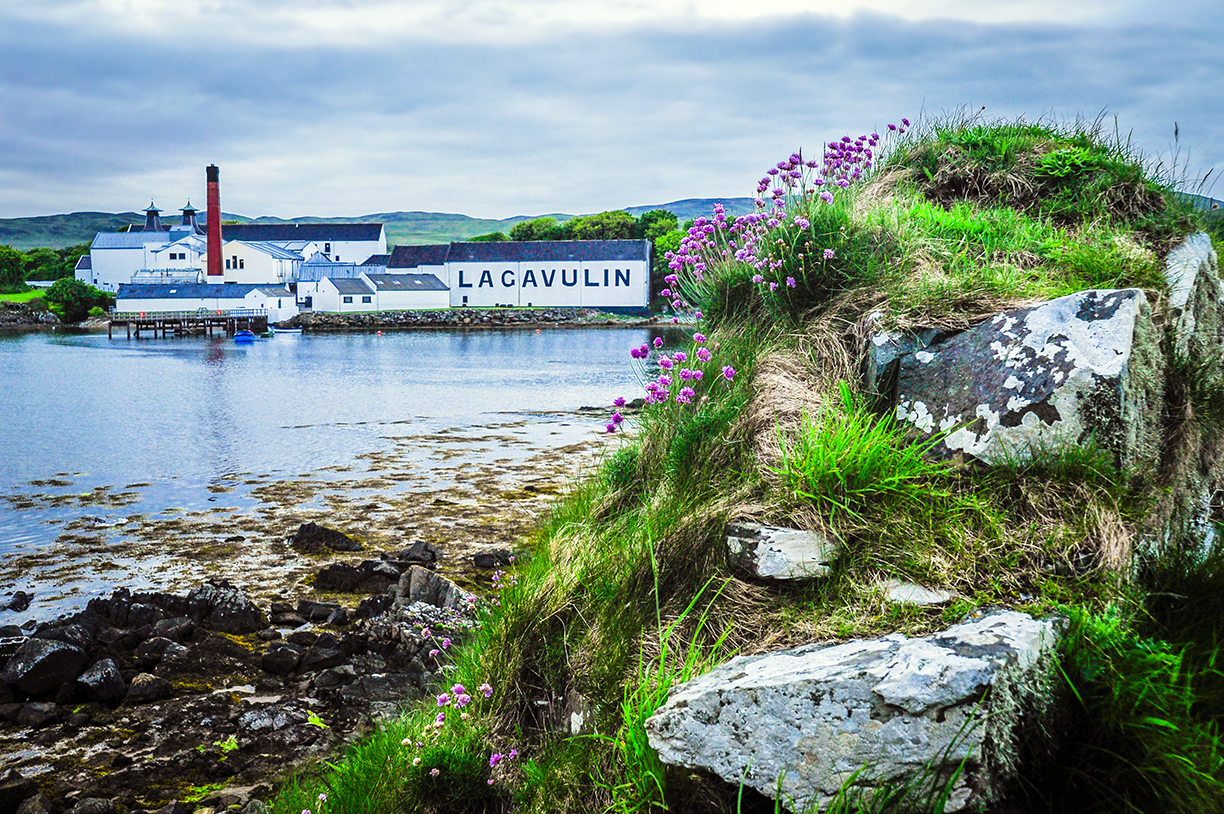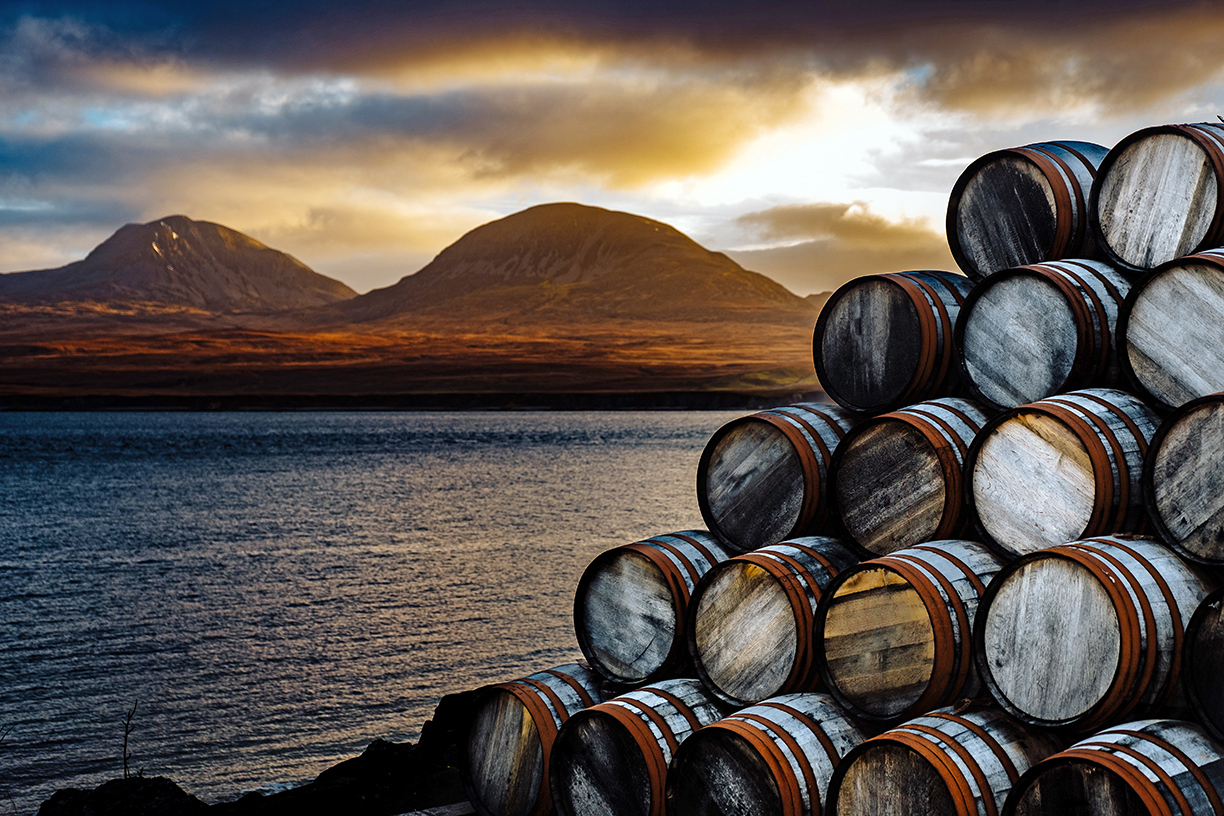A closer look at distinguishing qualities between Scotch and Bourbon.
by Chantele Machado
Throughout the world, there are several types of whisky, or whiskey; though among them all, Scotch and bourbon are two of the most beloved varieties. And while they do share some commonalities, their differences are immense, from the ingredients and flavor profiles to the distillation and aging process.
Location
Contrary to popular belief, bourbon whiskey is not required to be distilled inside the state of Kentucky. It can, in fact, be made anywhere throughout the United States. Although, Kentucky makes an ideal location due to the state’s famous limestone water, which is rich in nutrients like magnesium and calcium that are optimal for distilling and aids in the fermentation process. Conversely, in order to bear the title Scotch whisky, the spirit must be produced, as well as bottled, within the country of Scotland. Across the nation are five distinguished whisky-producing regions; the Highlands and Islands, Lowlands, Speyside, Islay and Campbeltown, each delivering their own regional characteristics and unique flavors.
Speyside is by far the biggest whisky–producing region in Scotland with more than 50 distilleries, while Campbeltown is home to merely three.
Ingredients
To qualify as a bourbon whiskey, its mash bill must be made up of at least 51% corn, with the remainder comprising a mix of other cereal grains like malted barley, rye and wheat. The spirit must also be free from any additives, such as coloring or flavoring, as to maintain an authentic and unadulterated profile. In contrast, the primary ingredient in Scotch whisky is barley. Grain whisky can vary with a combination of ingredients like malted and unmalted barley, corn and wheat.

malt whisky, on the other hand, must be produced from 100% malted barley. Additionally, Scotch cannot be sweetened or contain any additives other than plain caramel for coloring.
Distillation
In bourbon making, the mash bill will ferment for several days before being transferred into a column still with all the original grain solids remaining in the mixture. The resulting liquid, called distiller’s beer, is then boiled, vaporizing the alcohol through the top of the column and directing it into a doubler, where it is distilled once more to remove any further impurities.
The remnants and spent grain left behind in the column still, termed as sour mash, is sometimes reintroduced into the fermentation process to make sour mash bourbon, another variety of whiskey. While bourbon whiskey is allowed to be distilled up to 160 proof, the distillate must be reduced to 125 proof or lower prior to barreling, as required by law. Alternatively, in Scotch distillation, what is referred to as wort is separated from its spent barley grains before beginning its fermentation process.
After spending two to four days in containers called wash backs, the liquid produced during fermentation is distilled first in a wash still to boil off the alcohol from the water, yeast and pot ale. The remaining distillate, known as low wines, then passes into a second spirit still to be distilled another time. Before being barreled, the foreshots and feints of the whisky are both channeled off to be redistilled with the low wines in the next batch. Only the pure center cut, or heart of the run, which averages around 130 proof, is collected.
Terms to Know
ANGEL’S SHARE
The alcohol that evaporates from a cask as the whisky is maturing in a warehouse.
COLUMN STILL
A tall industrial still that uses steam injection and allows for continuous, mechanized distillation that produces a cleaner spirit than a pot still does.
DOUBLER
A type of copper pot still commonly used in conjunction with a column still for the second round of distillation, especially for bourbon.
FORESHOTS
The more volatile compounds which distil off first during Scotch distillation.
FEINTS
The oilier compounds that are vaporized during Scotch distillation.
MASH BILL
The mixture of grains used to make bourbon.
PEAT
A compressed organic substance consisting of grasses, plants, tree roots and mosses that is used to dry malted barley and infuses a distinct peaty flavor.
POT STILL
A style of copper still that is most common in the distillation of single malt whisky.
SPIRIT STILL
The second, and often smaller, pot still used in the distillation of Scotch.
WASH STILL
The first, and often larger, pot still used in the distillation of Scotch.
WHISKEY
The spelling used by American and Irish distilleries.
WHISKY
The spelling used by Scotland, Canada, India, Japan and most of the rest of the world.
WORT
A warm and sugary solution that contains the soluble sugars from the malted barley dissolved in warm water.
Aging
Generally speaking, bourbon does not have a minimum aging require-ment, although, for a spirit to have the distinction of a ‘straight bourbon,’ it must be aged for at least two years. In addition, any bourbon aged less than four years must include an age statement on its label. Bourbon whiskey must also, by law, be aged in new charred oak barrels, which greatly contributes to the color characteristics and aging process.
This is a key difference in that Scotch distilleries have a large amount of freedom in choosing from a range of casks for which to age their spirits, including those which formerly contained wine, port, sherry and cognac, among others. This wide selection of vessels is part of tradition and allows distillers greater creative experimentation, having given rise to the method of finishing Scotch in secondary barrel; a common practice used today. And while several Scotch whiskies are aged for as many as 12, 15 and even 25 years, the minimum years for which a Scotch must be aged is three years.
Kentucky’s hotter climate results in more of the whiskey evaporating away as “the angel’s share” than is the case in Edinburgh, so aging a barrel of whiskey in Kentucky for 25 years pro- duces far less whiskey than would be the case in Scotland, and therefore a more rarefied product.
Flavor
Bourbon’s high proportion of corn lends the spirit to have a sweeter flavor profile compared to that of many other whiskeys, especially Scotch. Without the elements of added flavors or coloring, much of a bourbon’s character relies heavily upon the charred surface of new oak barrels from which it often develops oaky, vanilla and caramel notes.
Scotch is much more complex and boasts a greater range of flavors than bourbon, given the wider cask selection, opportunity for blends and the age-old regions throughout Scotland renowned for flavors distinct to them. Whiskies that come from the Highlands and Speyside are better known for a lighter, fruitier and sweeter profile than that of a robust, smoky and peaty beast from Islay. The Lowlands often produce mellow drams with floral tones, and the peninsula of Campbeltown is noted for the dryness and sometimes pungency of its Scotch.



All photos courtesy LuxuryRealEstate.com
Content originally provided by LuxuryRealEstate.com.
You love nothing more than uncorking an expensive bottle of wine, or enjoying a nice glass of whisky. Have you ever thought about investing in these passions?
Always popular among the luxury class, passion investments such as wine and liquor, art, watches, or coins are non-traditional ways of putting your money into physical objects that give you enjoyment. In recent years, these luxury investments have experienced significant growth, with fine wine and liquor — specifically whisky — turning out to be some of the most lucrative passion investments.

©iStockphoto.com/MinervaStudio
Wine
When it comes to wine, Andrew della Casa of The Wine Investment Fund understands the profitability of this favorite drink of many, and provides investment management of fine wines to clients through a set of established methods to ensure low-risk portfolios. “You have to look at the number of millionaires and billionaires and realize that these numbers are increasing; and they are buying these wines,” says della Casa.
“The demand is increasing because there are more people coming to buy these wines. The only thing that can move is the price, and that tends to move upwards. If you look at the gold or stock exchange, since the 1980s, gold has gone up about four times,” he says. “Wine has gone up 20 times — that puts it in perspective.”

©iStockphoto.com/PaulGrecaud
For della Casa and his team, their focus includes only investment-grade wines that can achieve and deliver absolute high returns. “The thing that attracted us to the asset class was the specific characteristics that certain wines have. It’s not just any wine or any fine wine, basically it’s a specific number of Bordeaux wines from the French region of Bordeaux,” says della Casa. “There are delicious Italian, American, African wines, and that’s fine. But that’s not what we’re about. We’re about risk analysis and risk management.”
These wines include those from the finest Bordeaux chateaux, and those that are deemed low volatility — meaning to avoid wines at the en-primeur stage, trophy wines or ones nearing the end of their optimum drinking period.
“Burgundy is the area closest to having the characteristics to Bordeaux wines, but the quantities produced are minimal,” says della Casa. “Because we’re buying and selling Bordeaux wines, the characteristics of that wine is that it’s long living so you can keep it for 20 to 30 years. Also, formula clarity, so it gets better with time.”
Della Casa asserts the importance of understanding wine investment is an alternative, rather than mainstream investment. It’s important to think about a five-year horizon at a minimum, and a limited amount of money (no more than 20 percent) from your investment portfolio should go into fine wine.
“One of the biggest risks in any investment is liquidity — to get in and out of the market whenever you want to, not when the market dictates,” says della Casa. “Wines that we look at are wines that have a strong following. There is a demand for these wines from all over the world,” he says.
The demand for these wines comes from the traditional drinker, as well as a newfound demand from Asia, which is not as long standing — they drink the wine much younger. “You can buy any wine, but it’s only when you sell it that you crystallize your gain,” he says. “You can get a 20-fold increase in value with very low risk. Look at the volatility of our portfolio and compare it to gold, or even oil; we’re very much less risky. From an investment point of view, low risk and high return. Plus, you have a physical asset.”
Whisky
Liquor offers another realm of alternative investment — and one of the most lucrative investment liquors has been and continues to be whisky. For Andy Simpson of Rare Whisky 101, who was introduced to whisky — particularly scotch — at a young age by his father, it was an accidental investment at first. “I started holding on to bottles because I had too many to drink and then realized that what I had bought for 10 to 15 pounds started to be worth 40 and 50 pounds, and I thought, could this be an investment?”
“I’ve always said, it’s an investment of passion,” says Simpson, who has been collecting for nearly 30 years and helps collectors and investors all over the world source scotch and put together world-leading collections of whisky. “People fall in love with a category, the distillery, the spirit, the legend behind it. The rules are that first you love whisky — because then it’s going to be a fun investment. Second, patience is key. While there are significant short-term gains available, it is a medium to long-term investment.”
“From an investment perspective, age matters. The older the better. But from a flavor perspective, sometimes older whisky can be worse. It can be over matured, or develop an imbalance. Yet, generally, the further back the better,” says Simpson who has personally tasted the world’s oldest — a 75-year-old whisky — and many other pre-World War II bottles.

Photo courtesy of The Macallan.
Iconic distilleries Simpson directs his clients to include Lagavulin, Talisker, Dalmore, as well as silent distilleries (those no longer producing whisky) such as Port Ellen and Brora, both soon to be reopened, and Rosebank. Commemorative limited edition bottles, distillery exclusives offered only on property, or classic ones such as the Macallan Royal Marriage bottles are always great investments. “Macallan is the Rolls Royce of collectable whiskies by a country mile,” says Simpson. The Kate and William special wedding scotch was sold for 150 pounds in 2011, and now sells for 4,000 pounds a bottle.
“The overarching principle of whisky investment is to buy the best quality liquid. Someone’s investment today is going to be someone’s favorite drink tomorrow,” says Simpson. “It if wasn’t for collectors or investors, we couldn’t be drinking, buying, opening or sharing some of the oldest bottles of whisky in the world.”
Most collectors use the two-bottle approach: buy one to keep and one to drink. Yet, sometimes this is difficult to do, as some sellers may only allow one bottle to be purchased. “We deal with people who have meaningful collections of only 50 bottles; others have 10,000 bottles, some of the biggest collections in the world,” says Simpson. “You don’t need to spend more than a couple hundred pounds for a good investment.”

©iStockphoto.com/TWSTIPP
“We split the risks into your physical storage or logistical risks, and then financial risks,” says Simpson. “The main one being the “dreaded double D: drink it or drop it.” There are of course risks from storing as well. “Since whisky has a strong percentage of alcohol (it has to be 40 percent to be legal) the strength of the alcohol will corrode through the cork stopper, and it leads to leaking and evaporation damage. Therefore, whisky should always be stored standing up at room temperature and kept out of direct sunlight. Place it in a cupboard or closet and keep it out the reach of thirsty guests,” says Simpson.
Lastly, one of the main risks plaguing the whisky market — also seen with wine as well — are fakes, with most false bottle transactions occurring across peer-to-peer auction sites, and causing a potential for significant losses. Besides these risks, Simpson asserts that the market is especially buoyant with significant price increases for certain bottles and brands, and promises to be a wonderful speculative alternative investment. “If you get a great bottle, with a great closure, you can be sure it will outlast you and I,” says Simpson.















